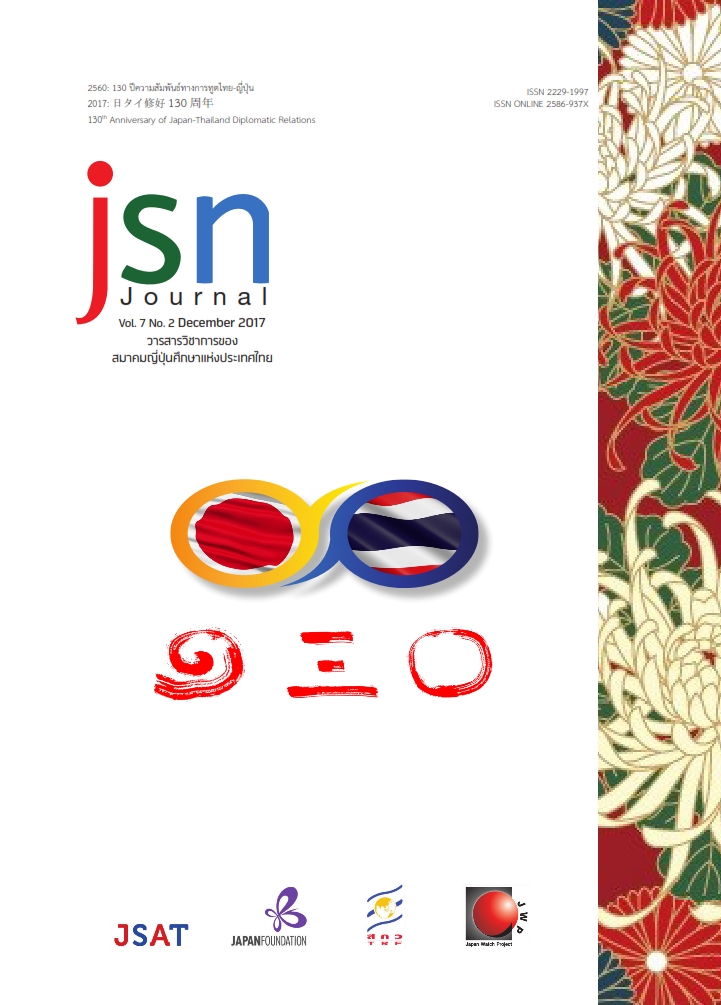Development of Directions for Learning and Teaching Japanese with Project-based Learning for Japanese Learners in Higher Education
Main Article Content
Abstract
This research article presents directions for learning and teaching Japanese employing project-based learning for Japanese learners in higher education. The theoretical frameworks for this study include social constructivism, second language acquisition, and dual language instruction. The study is a documentary research, which collected data from various sources including academic and research articles, textbooks, websites, dissertations, and Japanese books. The data analysis was based on the frameworks. The findings suggest that directions for learning and teaching Japanese using project-based learning for Japanese learners in higher education consist of 1) planning; 2) learners’ skill preparation for investigation; data collecting, analysis, and language proficiency; 3) project presentation; and 4) evaluation.
Article Details
ข้อความและข้อคิดเห็นต่างๆ ในบทความเป็นของผู้เขียนบทความนั้นๆ ไม่ใช่ความเห็นของกองบรรณาธิการหรือของวารสาร jsn Journal
References
จินตวีร์ คล้ายสังข์ (2560). การผลิตและใช้สื่ออย่างเป็นระบบเพื่อการเรียนรู้ในศตวรรษที่ 21. สำนักพิมพ์แห่งจุฬาลงกรณ์มหาวิทยาลัย.
ดวงใจ จงธนากร. (2014). Project-Based Learning กับการเรียนการสอนภาษาญี่ปุ่น. วารสารเจแปนฟาวน์เดชั่นกรุงเทพฯ, 11, 12-19.
ธิติสรณ์ แสงอุไร. (2556). ความพึงพอใจของบัณฑิตต่อการเรียนการสอนภาษาญี่ปุ่นด้านการฟังและการพูดกับความสอดคล้องกับความต้องการของบริษัทญี่ปุ่นในประเทศไทย. วิทยานิพนธ์อักษรศาสตร์มหาบัณฑิตคณะอักษรศาสตร์ จุฬาลงกรณ์มหาวิทยาลัย.
Alan, B., & Stoller, F. (2005). Maximizing the Benefits of Project Work in Foreign Language Classrooms. Retrieved from http.//exchanges.state.gov/forum/vols/vol43/no4/ p10.htm
Beckett, G. H., & Miller, P. C. (2006). Project-Based Second and Foreign Language Education: Past, Present, and Future. Greenwich, Connecticut: Information Age Publishing.
Beckett, G. H., & Staller, T. (2005). The project framework: A tool for language and content integration. English Language Teaching Journal, 59, 108-116.
Bell, S. (2010). Project-Based Learning for the 21st Century: Skills for the Future. The Clearing House: A Journal of Educational Strategies, Issues and Ideas, 83 (2), 39-43.
Ellis, R. (1999). Learning a second language through interaction. Amsterdam, Philadelphia: John Benjamins.
Grant, M. M. (2002). Getting a grip on Project-Based-Learning: Theories, Cases, and Recommendations. Meridian Journal, 5(1), 1-17.
Group Jammassy. (2554). พจนานุกรมรูปประโยคภาษาญี่ปุ่น: รวม 3,000 รูปประโยคที่ควรรู้.『日本語 文型辞典』 (บุษบา บรรจงมณี, ปราณี จงสุจริตธรรม, ประภา แสงทองสุข, ผู้แปล). กรุงเทพฯ: สำนักพิมพ์ภาษาและวัฒนธรรม สสท. (ต้นฉบับพิมพ์ ปี พ.ศ. 2554)
Hamayan, E., Genesee, F., & Cloud, N. (2013). Dual Language Instruction: Practical Guidance for Teachers and Administrators. Portsmouth, NH: Heinemann.
Intercultural Institute of Japan. (2017). Study Period and Proficiency Level. Retrieved from http://www.incul.com/eng/japanese_school/long-term.php
Jakar, V. (2006). Knowing the other through multicultural projects in school EFL programs. In Beckett, G. H., & Miller, P. Ch. (Eds.), Project-Based Second and Foreign Language Education: Past, Present, and Future (pp.181-193). Greenwich, Connecticut: Information Age Publishing.
Japanese Language Education Center. (2017). JLPT Study Hour Comparison Data 2010-2015. Retrieved from https://web.archive.org/web/20151117033458/ http://www.studytoday.com
Kerdpol, S. (2016). An Application of Project-Based Learning on the Development of Young Local Tour Guides on Tai Phuan’s Culture and Tourist Attractions in Sisatchanalai District, Sukhothai Province. English Language Teachin, (9),1, 133-141.
Markham, T., Mergendollar, J., Larmer, J., & Ravits, J. (2003). Project-Based Learning Handbook. Canada: Buck Institute For Education.
Mills, J. E., & Treagust, D. F. (2003). Engineering education—Is problem-based or project-based learning the answer?. Australasian Journal of Engineering Education, 3, 2-16.
Mitchell, R., & Myles, F. (1998). Second Language Learning Theories. London: Arnold.
Nassir, S. (2014). The Effectiveness of Project-based Learning Strategy on Ninth Graders’ Achievement Level and their Attitude towards English in Governmental Schools -North Governorate. Unpublished dissertation, The Islamic University of Gaza, Gaza, Israel.
Nation, M. L. (2006). Project-Based Learning for Sustainable Development. Journal of Geography, 107 (3). 102-111.
NYC Department of Education. (2009). Project-Based Learning: Inspiring Middle School to engage in deep and active learning. New York, New York: Author.
Partnership for 21st Century Learning. (2002). Learning Framework for 21st Century. Retrieved from URL://www.p21.org/our-work/p21-framework
Phonlabutra, K. (2010, December). The Integration of Project-Based Learning and Japanese for Tourism in Thailand: A Case Study of Phetchaburi Rajabhat University. Paper presented at The Asian Conference on Education, Osaka, Japan.
Ravitz, J., Hixson, N., English, M., & Meagandoller, J. (2012, April). Using project-based learning to teach 21st century skills: Findings from a statewide initiative. Paper presented at Annual Meetings of the American Educational Research Association. Vancouver, BC.
Simpson, J. (2011). Integrating Project-Based Learning in an English Language Tourism Classroom in a Thai University. Unpublished doctoral dissertation, Australian Cathoric University, North Sydney, Australia.
Slater, T., Beckett, G. H., & Aufderhaar, C. (2006). Assessing projects as second language and content learning. In Beckett, G. H., & Miller, P. Ch. (Eds.), Project-Based Second and Foreign Language Education: Past, Present, and Future (pp.241-260). Greenwich, Connecticut: Information Age Publishing.
Stauffacher, M. A., Walter, A. I., Lang, D. J., Wiek, A., & Scholz, R. W. (2006). Learning to research environmental problems from a functional socio-cultural constructivism perspective: The transdisciplinary case study approach. International Journal of Sustainability in Higher Education. 7(3), 252-275.
Takeda, I. (2016). Project-Based Learning with 21st Century Skills for the Japanese Language Classroom. Journal of Integrated Creative Studies. Retrieved from www2.yukawa.kyoto-u.ac.jp/~future/icis/wp/wp-content/.../2016/10/2016-020-e.pdf
Thomas, J. W. (2000). A Review of Research on Project-based Learning. Retrieved from http://www.bie.org/index.php/site/RE/pbl-research/29
Tsukuba language group. (1995). Situational Functional Japanese (Volume1: Notes). (2nded.). Tokyo: Bonjinsha.
_______. (1995). Situational Functional Japanese (Volume2: Notes). (2nd ed.). Tokyo: Bonjinsha.
_______. (1995). Situational Functional Japanese (Volume3: Notes). (2nd ed.). Tokyo: Bonjinsha.
Verenikina, I. (2003, November). Understanding Scaffolding and the ZPD in Educational Research. Paper presented at the International Educational Research Conference AARE – NZARE, Auckland, New Zealand.
アーパーポーン ナオサラン. (2016). 「Project Based Learning を取り入れた日本語授業 及び 日本語キャンプの実践を通してのタイ人教師の気付き」,日本語教育国際研究大 会ポスター発表,国際交流基金バンコク日本文化センター,http://bali-icjle2016.com/wp-content/uploads/gravitforms/2-ec131d5d14e56b102d22ba31c4c20b9c/2016/08/Arpaporn-Naosaran_Teachersfull-paper10sep.pdf?TB_iframe=true
安藤節子・田口典子・佐々木薫・赤木浩文・坂本まり子(2001).『トピックによる日本 語総合演習』.東京:スリーエーネットワーク.
中尾有岐(2016).「21世紀型スキル育成を目指した学習者体験型教師研修-タイ人中 等教育教師の気付きと学び -」『国際交流基金日本語教育紀要』12: 41-55.
堀井惠子・種村政男 (2013). 「ビジネス日本語教育におけるシニアサポーターの役割 ―PBL 授業実践から―『日本語教育実践研究フォーラム報告』www.nkg.or.jp/pdf/jissenhokoku/2013_P09_horii.pdf


